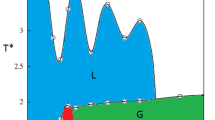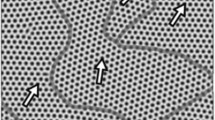Abstract
The model of a thin film sandwiched between two parallel planes the gap between which is filled with the melt of diblock copolymers is revisited. One of the planes (a supporting plane) has a pattern, whereas the other plane (an upper) is uniform. The proposed model is based on mean self-consistent field concepts. The parameters of diblock copolymers are selected so that the melt of diblock copolymers yields a hexagonal morphology in its volume. The upper boundary of the film and support avoid contact with the minor component of the diblock copolymer; as a result, in the film, a hexagonal morphology parallel to the support is formed. When hexagonal and rectangular patterns with preferential interaction with the minor component (the period of patterns coincides with the period of hexagonal symmetry in the volume), the hexagonal morphology changes its orientation from parallel to perpendicular relative to the support. The hexagonal morphology changes its orientation at sufficiently strong interaction between the pattern and minor component. Structural factor is calculated, and characteristic features in the location of peaks for perpendicular and parallel phases of hexagonal morphology are found. The development of additional peaks in the structural factor comes from deformations induced by the interaction between components of the melt of diblock copolymers with the upper boundary, support, and pattern.
Similar content being viewed by others
References
L. Leibler, Macromolecules 13, 1602 (1980).
F. S. Bates and G. H. Fredrickson, Annu. Rev. Phys. Chem. 41, 525 (1990).
K. Binder, Computational Modeling of Polymers (Springer, New York, 1992).
I. Ya. Erukhimovich and A. R. Khokhlov, Polymer Science, Ser. A 35 (1993) [Vysokomol. Soedin., Ser. A 35, 1808 (1993)].
M. W. Matsen and M. Schick, Macromolecules 27, 6761 (1994).
S. Bates and G. H. Fredrickson, Phys. Today 33(52), 32 (1999).
H. D. Ceniceros and G. H. Fredrickson, Multiscale Model. Simul. 2, 452 (2004).
G. H. Fredrickson, The Equilibrium Theory of Inhomogeneous Polymers (Oxford Univ. Press, New York, 2006).
Yu. A. Kriksin, I. Ya. Erukhimovich, P. G. Khalatur, et al., J. Chem. Phys. 128, 244903 (2008).
Yu. A. Kriksin, P. G. Khalatur, I. Ya. Erukhimovich, et al., Soft Matter, No. 5, 2896 (2009).
A. Alexander-Katz, A. G. Moreira, and G. H. Fredrickson, J. Chem. Phys. 118, 9030 (2003).
M. W. Matsen, J. Chem. Phys. 108, 7781 (1997).
H. P. Huinink, J. C. M. Brokken-Zijp, and M. A. Van Dijk, J. Chem. Phys. 112, 2452 (2000).
H. Yi. Chen and G. H. Fredrickson, J. Chem. Phys. 116, 1137 (2002).
D. Meng and Q. Wang, J. Chem. Phys. 126, 234902 (2007).
A. K. Chakraborty and A. J. Golumbfskie, Annu. Rev. Phys. Chem. 52, 537 (2001).
K. Ch. Daoulas, M. Müller, J. J. De Pablo, et al., Soft Matter, No. 2, 573 (2006).
T. L. Morkved, M. Lu, A. M. Urbas, et al., Science (Washington, D. C.) 273, 931 (1996).
G. Coulon, T. P. Russell, V. R. Deline, and P. F. Green, Macromolecules 22, 2581 (1989).
S. H. Anastasiadis, T. P. Russell, S. K. Satija, and S. F. Majkrzak, J. Chem. Phys. 92, 5677 (1990).
B. L. Carvalho and E. L. Thomas, Phys. Rev. Lett. 73, 3321 (1994).
K. S. Lyakhova, A. Horvat, A. V. Zvelindovsky, and G. J. A. Sevink, Langmuir 22, 5848 (2006).
L. Tsarkova, A. Knoll, and R. Magerle, Nano Lett. 6, 1574 (2006).
A. Knoll, L. Tsarkova, and G. Krausch, Nano Lett. 7, 843 (2007).
A. Horvat, A. Knoll, G. Krausch, et al., Macromolecules 40, 6930 (2007).
T. Xu, J. Hawker, and T. P. Russel, Macromolecules 36, 6178 (2003).
T. Thurn-Albrecht, J. DeRouchey, T. P. Russell, and R. Kolb, Macromolecules 35, 8106 (2002).
T. Xu, A. V. Zvelindovsky, G. J. A. Sevink, et al., Macromolecules 38, 10788 (2005).
M. W. Matsen, Macromolecules 39, 5512 (2006).
R. Ruiz, H. Kang, F. A. Detcheverry, et al., Science (Washington, D. C.) 321, 936 (2008).
I. Bita, J. K. W. Yang, Y. S. Jung, et al., Science (Washington, D. C.) 321, 939 (2008).
Ch. Tang, E. M. Lennon, G. H. Fredrickson, et al., Science (Washington, D. C.) 322, 429 (2008).
S. Xiao, X. Yang, S. Park, et al., Adv. Mater. (Weinheim, Fed. Repub. Ger.) 21, 2516 (2009).
E. Yu. Kramarenko, I. I. Potemkin, A. R. Khokhlov, et al., Macromolecules 32, 3495 (1999).
E. Yu. Kramarenko, P. G. Khalatur, I. I. Potemkin, and A. R. Khokhlov, Macromolecules 33, 150 (2000).
M. J. Fasolka and A. M. Mayes, Annu. Rev. Mater. Res. 31, 323 (2001).
Y. Tsori and D. Andelman, Macromolecules 34, 2719 (2001).
Y. Tsori and D. Andelman, Europhys. Lett. 53, 722 (2001).
I. I. Potemkin and M. Möller, Macromolecules 38, 2999 (2005).
D. Petera and M. Muthukumar, Chem. Phys. 109, 5101 (1998).
M. Birkholz, P. F. Fewster, and C. Genzel, Thin Film Analysis by X-Ray Scattering (Wiley, Weinheim, 2006).
Author information
Authors and Affiliations
Corresponding author
Additional information
Original Russian Text © Yu.A. Kriksin, P.G. Khalatur, A.R. Khokhlov, 2010, published in Vysokomolekulyarnye Soedineniya, Ser. A, 2010, Vol. 52, No. 6, pp. 982–992.
This work was supported by the Russian Foundation for Basic Research, project no. 10-03-00763, and DFG, SFB 569, project B13.
Rights and permissions
About this article
Cite this article
Kriksin, Y.A., Khalatur, P.G. & Khokhlov, A.R. Effect of the supporting pattern on the orientation of hexagonal morphology in thin films of diblock copolymers. Polym. Sci. Ser. A 52, 645–654 (2010). https://doi.org/10.1134/S0965545X10060118
Received:
Revised:
Published:
Issue Date:
DOI: https://doi.org/10.1134/S0965545X10060118




